 |
Elements of a Slide...
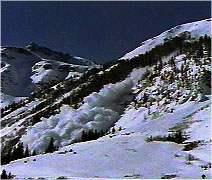 Avalanches are a significant mountain hazard—responsible for more
deaths each year in the United States than earthquakes. Once in motion, snow
slides are a powerful force of nature, capable of snapping off mature trees
like match sticks, and easily destroying buildings. And when an avalanche
finally stops, the snow sets up like concrete, making rescue efforts extremely
difficult, and chances for survival slim.
Avalanches are a significant mountain hazard—responsible for more
deaths each year in the United States than earthquakes. Once in motion, snow
slides are a powerful force of nature, capable of snapping off mature trees
like match sticks, and easily destroying buildings. And when an avalanche
finally stops, the snow sets up like concrete, making rescue efforts extremely
difficult, and chances for survival slim.
An avalanche, or slide, is simply a mass of snow moving down a slope. There are
two basic elements to a slide; a steep, snow-covered slope and a trigger. But
despite this apparent simplicity, avalanches can be surprisingly hard to
predict. Changing weather conditions continually affect the strength of the
layers within the snowpack, and the snowpack on every slope is different
depending on what exposure that slope has to the wind and sun.
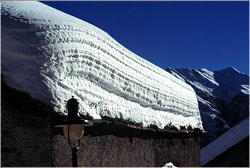 In fact, layers within the snowpack are the first thing that avalanche
forecasters look at to try to predict the stability of a slope and its
potential to slide. Different storms create distinct types and amounts of
snow. Once the snow settles onto the existing snowpack, it can quickly
metamorphose into distinct crystal types, which are determined both by changes
in temperature and whether or not the snow is exposed to the sun.
In fact, layers within the snowpack are the first thing that avalanche
forecasters look at to try to predict the stability of a slope and its
potential to slide. Different storms create distinct types and amounts of
snow. Once the snow settles onto the existing snowpack, it can quickly
metamorphose into distinct crystal types, which are determined both by changes
in temperature and whether or not the snow is exposed to the sun.
As the season progresses, the snowpack becomes a multi-layered history of
storms and weather. But even a deeply buried layer can continue to change, as
changes in temperature slowly move through the snowpack, and heavier snow
weighs down on lower layers. A weak layer is created whenever snow crystals are
shaped in a way that prevents them from bonding tightly together.
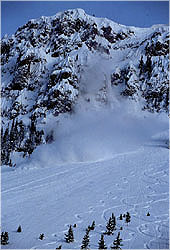 How much of a threat an avalanche may pose depends largely on how deeply buried
a weak layer is. When the snow near or on the surface doesn't have much
cohesion—in other words, it's a weak layer—loose snow slides are common.
The snow on the surface begins to slide from a single point, collecting more
snow as it moves, and widening out into a triangular shape, creating what is
commonly called a sluff. Sluffs are similar to sand rolling down a sand dune.
Typically, these loose snow avalanches do not involve much snow and are not a
major threat to people or property.
How much of a threat an avalanche may pose depends largely on how deeply buried
a weak layer is. When the snow near or on the surface doesn't have much
cohesion—in other words, it's a weak layer—loose snow slides are common.
The snow on the surface begins to slide from a single point, collecting more
snow as it moves, and widening out into a triangular shape, creating what is
commonly called a sluff. Sluffs are similar to sand rolling down a sand dune.
Typically, these loose snow avalanches do not involve much snow and are not a
major threat to people or property.
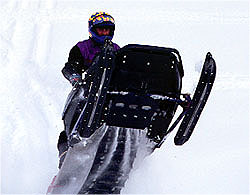 But the threat of larger avalanches increases as a weak layer becomes more and
more deeply buried, causing the entire snowpack above to become more unstable.
When a weak layer is buried underneath a strong layer, slab avalanches are
possible—if enough stress is added to the slope. Stresses which might
trigger a slab avalanche include new or wind-blown snow, a skier or
snowmobiler, or an explosive used intentionally for avalanche control. But the threat of larger avalanches increases as a weak layer becomes more and
more deeply buried, causing the entire snowpack above to become more unstable.
When a weak layer is buried underneath a strong layer, slab avalanches are
possible—if enough stress is added to the slope. Stresses which might
trigger a slab avalanche include new or wind-blown snow, a skier or
snowmobiler, or an explosive used intentionally for avalanche control.
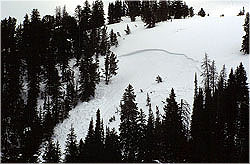 In a slab avalanche the snow breaks off in a single large plate, which then
fractures and moves down the slope. These avalanches tend to be much larger,
involve more snow, and are more dangerous to both people and property than
sluffs. When people trigger them they are often in the middle of the slab,
which is what makes them so deadly; when the avalanche releases the victim is
quickly engulfed in the snow, and the chances for escape are slim.
In a slab avalanche the snow breaks off in a single large plate, which then
fractures and moves down the slope. These avalanches tend to be much larger,
involve more snow, and are more dangerous to both people and property than
sluffs. When people trigger them they are often in the middle of the slab,
which is what makes them so deadly; when the avalanche releases the victim is
quickly engulfed in the snow, and the chances for escape are slim.
To find out ways to avoid getting caught in an avalanche, check out Snow
Sense.
Photos: (1) WGBH Educational Foundation; (2), (5) Kate Churchill/WGBH; (3-4) David Ruddick.
Capturing |
Making |
Elements |
Snow Sense |
Resources
Mail |
Teacher's Guide |
Transcript |
Avalanche Home
|